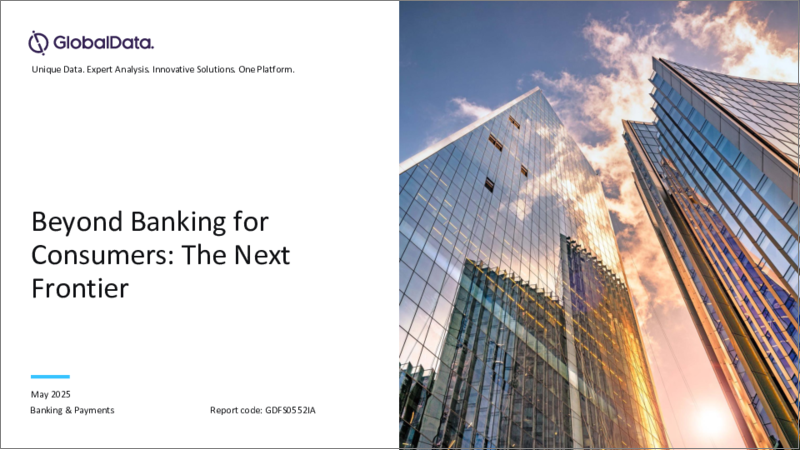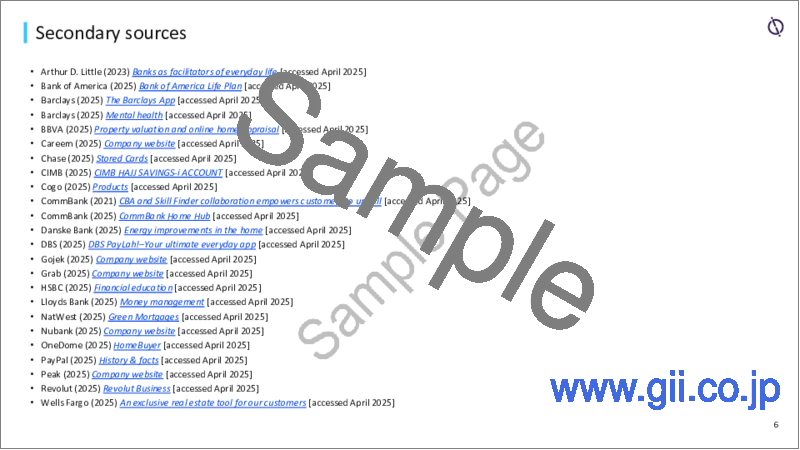|
|
市場調査レポート
商品コード
1730752
消費者のためのビヨンド・バンキング:ネクストフロンティアBeyond Banking for Consumers: The Next Frontier |
||||||
カスタマイズ可能
適宜更新あり
|
|||||||
| 消費者のためのビヨンド・バンキング:ネクストフロンティア |
|
出版日: 2025年05月01日
発行: GlobalData
ページ情報: 英文 37 Pages
納期: 即納可能
|
全表示
- 概要
- 目次
当レポートでは、銀行業務とエコシステム・バンキングの現状を概観・分析しています。フィナンシャル・ウェルネスと教育、マーケットプレースとライフスタイル・ベネフィット、コミュニティ・エンゲージメントと教育、住宅関連サービスなど、世界の既存企業が導入している既存のビヨンド・バンキング・ソリューションの一部を紹介しています。また、現在の銀行商品やサービスのバリューチェーン全体における利害関係者にとっての今後の機会や留意点など、ビヨンド・バンキング分野の展望も示しています。
ビヨンド・バンキングとは、銀行が中核的な金融商品や伝統的な銀行業務の枠を超えて、従来とは異なる幅広い非中核的商品や価値提案を提供し、より強化された総合的な価値提案を行うことです。既存銀行に対する技術革新のプレッシャーが高まっている背景には、金融・非金融の両チャレンジャーが革新的な商品やサービスで金融サービス業界に参入し、業界を破壊していることがあります。PayPalとNubankのような企業は、それぞれ決済と銀行業界に恒久的な破壊をもたらしました。金融緩和によって利ざやが減少し、すでにコストが高騰しているため、2025年にはさらなる金融圧力が続きます。
スコープ
- 「2024年金融サービス消費者調査」回答者の半数以上が、伝統的な銀行商品を提供する金融機関は依然として既存企業です。
- 残りの製品シェア(42~56%)は、競合企業によりほぼ均等に分けられており、単なる単一ツールとしての役割を終え、むしろあらゆる金融ニーズに対応する完全なプロバイダーとして機能していることを示しています。
- 現在、中小企業のビヨンド・バンキング・イニシアティブがこの分野をリードしていますが、AI、フィンテック企業、大手テック企業、スーパーアプリ、潜在的な貸出利ざやの縮小などによるディスラプションのため、リテール銀行は今後も商品の革新と多様化を迫られ続けると思われます。
購入の理由
- かつては中小企業に特化していた銀行業務が、進化する消費者ニーズにどのように対応できるかを理解します。
- 銀行がライフスタイル、ウェルネス、付加価値サービスを消費者向けサービスに組み込む機会を探る。
- 金融機関は、金融取引だけでなく、より幅広い人生の目標をサポートすることで、より深い関係を築くことができます。
目次
第1章 エグゼクティブサマリー
第2章 ビヨンド・バンキングのイントロダクション
第3章 ビヨンド・バンキング・イニシアティブ
第4章 住宅業界のビヨンド・バンキング
第5章 ビヨンド・バンキングの未来
第6章 結論
第7章 付録
This report provides an overview and analysis of the current state of beyond banking and ecosystem banking. It highlights some of the existing beyond banking solutions global incumbents have implemented across the likes of financial wellness and education, marketplace and lifestyle benefits, community engagement and education, and housing-related services. The report also provides an outlook for the beyond banking space, including future opportunities and considerations for stakeholders across the current banking products and services value chain.
Beyond banking involves banks increasingly offering an unconventional range of non-core products and value propositions that expand beyond the core set of financial products and traditional banking activities, to provide a more enhanced and holistic value proposition. The growing pressure for incumbent banks to innovate comes in one part from both financial and non-financial challengers entering and disrupting the financial services industry with innovative products and services. The likes of PayPal and Nubank brought about permanent disruption in the payments and banking industries respectively, while Big Techs increasingly move into the industry as some aim to build superapps. Added financial pressures persist in 2025 as monetary easing decreases interest margins, with costs already spiralling.
Scope
- Incumbents remain the preferred provider for traditional banking products for over half of GlobalData's 2024 Financial Services Consumer Survey respondents globally; just under half would use them for non-traditional activities.
- The remaining product market shares (42-56%) are fairly evenly split between challenger types, showing that they are past being just a single-use tool and rather serve as a complete provider for all financial needs.
- Although SME beyond banking initiatives lead the space currently, retail banks will continue to be pushed to innovate and diversify products due to disruptions from AI, fintech firms, Big Tech companies, superapps, and potentially thinning lending margins.
Reasons to Buy
- Understand how beyond banking, once focused on SMEs, can be adapted to meet evolving consumer needs.
- Explore opportunities for banks to embed lifestyle, wellness, and value-added services into consumer offerings.
- Gain insights into how financial institutions can build deeper relationships by supporting broader life goals, not just financial transactions.






